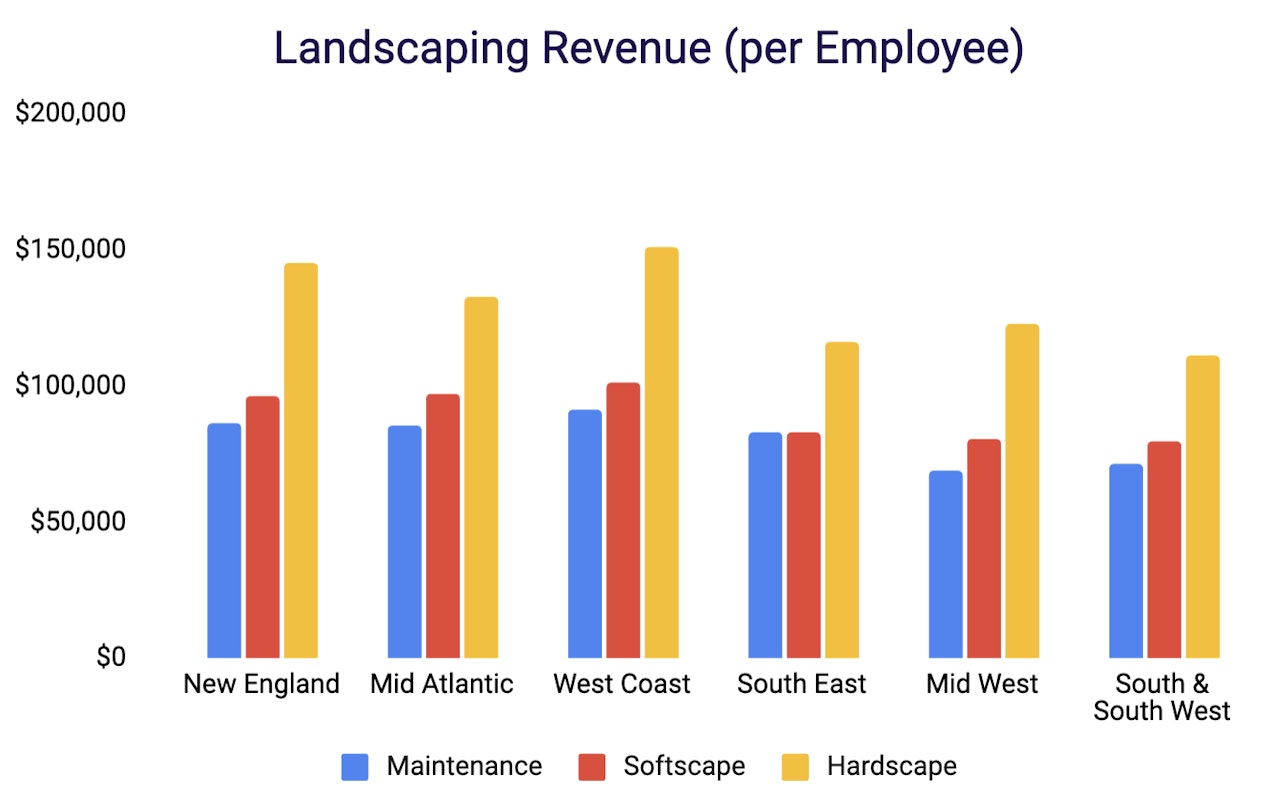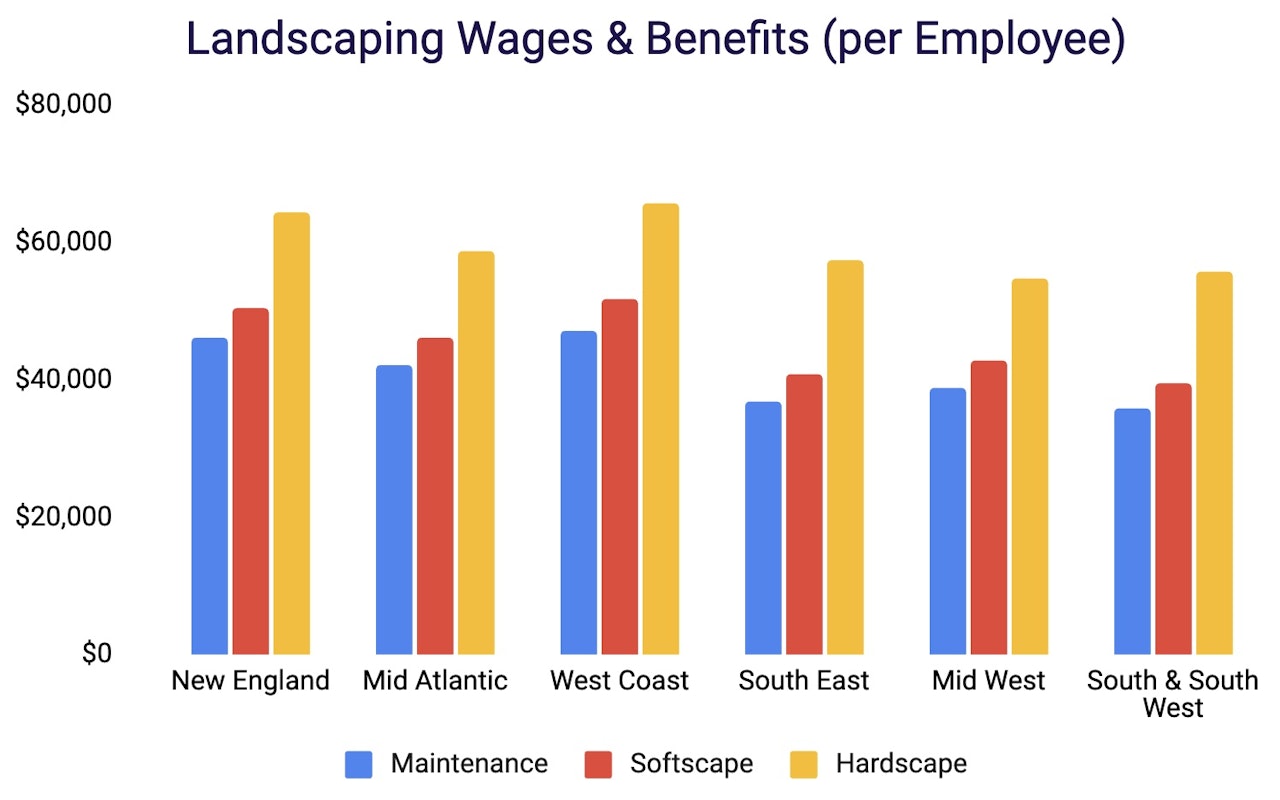If you have started a landscaping business and hired your first few employees, you may be asking "How much money can I really make running this company?" It's a smart question, and one every aspiring entrepreneur should ask. In this article we break down the math to help you predict how much money you can make, and we give you some tips to achieve your potential.

 Strategy
StrategySep 20, 2025
Landscaping Business Profit Margins & Revenue Potential
Learn how to go from startup to six figures. Your earnings potential is determined by the services you offer, the area you are in, and how tightly you manage your business.
Share This Article
What is a landscaping business?
In total, the landscaping industry generates over $200Bn a year in revenue, and is forecasted to grow at about twice the rate of the economy. There are over 1 million landscaping jobs, working as private businesses or as groundskeepers at larger firms.
Landscaping businesses are very diverse: landscapers maintain lawns, install mulch and plants, plow snow, apply chemicals, install irrigation systems, pour asphalt and build patios, among other things.
This diversity means that there is a slice of the pie for every landscaper job, whether you want to specialize or offer a full suite of services. The demand is consistent, often recession-resistant, as people always value their properties and land needs to be tended. On the other hand, a higher cost of living does reduce the budget available for other services.
Average profit margin for landscaping business owners
Profit margins for landscaping business owners can vary significantly. A solo operator focused purely on lawn maintenance might see a higher percentage profit margin on each job due to minimal overhead, vs a larger company offering complex design-build projects.
Typically, well-managed landscaping companies aim for net profit margins ranging from 10% to 20% after all expenses. However, some highly efficient and specialized operations can push past 25%. Most of your costs will come from payrolls: the average landscaper salary can range from $36,000 per year to $66,000 per year depending on the state and services you offer. However as a business owner, you can make significantly more than that as you will discover below.
Companies focused on high-margin services like landscape design and installation of elaborate outdoor living spaces often see better margins than those solely focused on recurring, lower-margin maintenance tasks. It’s about finding your sweet spot, balancing volume with profitability.
The factors that influence your landscaping income
There are several levers that affect your landscaping earning potential:
- The services that you offer
- The budgets of the clients in the areas that you operate
- The amount of competition in the areas you service
It is really important to understand the budgets of the customers that you service: make sure to understand both the average salaries in your areas of service and the cost of living.
How to estimate your revenue potential
To truly understand your earning potential, you need to break down where your money will come from. To keep it simple, we like to calculate how much money you can make per employee. That way you can quickly estimate how many people it will take for you to hit your goals.
- Revenue potential = Number of employees * revenue potential per employee
The revenue potential per employee is determined by the services you offer, and the budgets of the customers in your area. We find average revenue per employee ranges from $69,300 for maintenance work in the Mid West, to $151,351 for hardscape contractors on the West Coast.

Lawn maintenance revenue
This is often the bread and butter for many landscaping businesses. Think recurring services like lawn mowing, edging, blowing, weeding, fall and spring clean ups, and basic shrub trimming. These are consistent, predictable revenue streams, and the services can be performed by entry-level landscapers.
A single maintenance contract might only be $50 - $200 per visit for a homeowner, but multiply that by 60 clients over 30 weeks a year, and you quickly see the power of recurring revenue. This stability is invaluable, providing a base income even when other projects are slow.
Watch video on creating proposals in Duranta: Creating a Maintenance Proposal
Softscape revenue
This category includes planting new flowerbeds, shrub and tree installation, mulching and small garden renovations. These are often project-based, ranging from a few hundred to several thousand dollars per job, and you will need more experienced landscapers, in some cases landscape architects for this work.
While less predictable than maintenance, they offer higher revenue per project. Estimating this involves understanding your capacity for these larger jobs and having a strong marketing strategy to attract them.
Watch video on landscaping design in Duranta: Designing Beautiful Outdoor Spaces
Construction (or hardscape) revenue
This is where the big money often lies. "Construction" in landscaping refers to hardscaping: patios, walkways, retaining walls, outdoor kitchens, fire pits, and even pergolas. For a commercial property it could include asphalt repair, parking lot stripes, or pouring concrete.
These are higher paying, large-scale, often multi-day or multi-week landscaping projects that can easily range from $5,000 to $50,000+ per job. They require specialized skills, equipment, and often permits, but the profit margins can be excellent. If you have the expertise or plan to acquire it, this is a significant revenue booster: we estimate national average revenue per employee at $106,722.
Snow removal revenue
For businesses in colder climates, snow removal keeps your crews busy and generate revenue during the off-season. Plowing driveways, shoveling sidewalks, and de-icing commercial properties can be incredibly lucrative, especially during heavy snowfalls.
You can charge per event, per season, or hourly, with typical hourly rates ranging from $120 - $200. It perfectly complements your landscaping services, turning a potential downtime into a high-earning period.
Read more: How to create an accurate snow removal estimate
Watch video: Snow removal and ice management proposal in less than 5 minutes
Pest control revenue
While often a separate industry, many landscaping companies successfully integrate pest control, particularly for common lawn and garden pests. This includes insect control for turf, grub treatment, and even mosquito control. It's a natural add-on service for existing clients and can create another recurring revenue stream, increasing the value you offer and boosting your overall profitability.
Handling pesticides requires state certification and training so often there is less competition for people providing these services.
Read about using Duranta for pest control: 3 reasons pest control companies use Duranta
How to estimate your costs
Now for the other side of the equation: costs. Once again, we think that the easiest way to understand your costs it divide all your cost by the number of employees (for example, you can consider how much it would cost to outfit a 3 person crew). Here is a simple formula to help you estimate your costs:
- Costs = Number of employees * (hourly wages & benefits per employee + equipment and materials + overhead per employee)
When coming up with your costs, don’t forget to include your annual salary! In your first year your take home pay should be about 1.5 times your lead crew member, and it will grow significantly in later years as you build up your client base.
Read how to loose money: Understanding profit margins
Average landscaper salary costs
This is often your largest expense. We find that it ranges from $36,000 in Florida to $46,000 in New York for maintenance jobs, and from $55,800 in Texas to $65,800 in Washington for hardscaping jobs. Don't forget to factor in payroll taxes, workers' compensation insurance, benefits (if offered), and any overtime pay. Underestimating labor costs is a common pitfall for new businesses.

Equipment costs
From mowers, trimmers, and blowers to trailers, excavators, and skid steers, equipment is vital. This includes the initial purchase cost, ongoing maintenance (fuel, oil, repairs), and eventual replacement. In places like California, most of your equipment may need to be electric.
Materials
This category covers everything you purchase for jobs: plants, mulch, soil, pavers, gravel, fertilizer, weed control products, and irrigation supplies. Accurately estimating material needs for each job is crucial to avoid waste or costly last-minute trips to the supplier.
Property
Even if you work from your home, consider the space you'll eventually need for storing equipment safely and securely. We estimate that on average, rent and other overhead is about 10% of your people costs, however if you plan on servicing urban areas, this can become a much larger percentage.
Software
In today's AI (Artificial Intelligence) age, good software isn't a luxury; it's an essential part of your business planning. This includes a CRM (Customer Relationship Management) that keeps track of your customers, tools that use AI to help you estimate jobs, software for winning proposals, invoicing and accounting platforms, and even design software for elaborate projects.
While there's an initial investment, these tools dramatically increase efficiency, improve customer service, and help you track your finances, ultimately contributing to higher profitability.
Real-world examples: Success stories in Landscaping
Let's illustrate how these elements come together with a few examples of Duranta customers who are at different stages of growing their businesses.
The startup: Keenan - founder and CEO of GreenRoots
Business statistics:
- Lawncare maintenance
- Tree care
- Residential landscaping
- Team size: small business (< 5)
- Years of experience: < 2 (in his own company)
Duranta products used: CRM, Estimating, Proposals
Keenan is one of only 1,500 fully certified arborists in the US, and he uses his specialization to consult other companies, as well as run his own firm GreenRoots. Nick treats trees and tends lawns, working with a network of service companies to offer his expertise in a wider metropolitan area.
Keys to success:
- Certifications and education
- Mastering sales tactics
- Project management
The rapid riser: Aidan - founder and CEO of Average Guys, Amazing Results
Services:
- Lawn maintenance
- Landscaping
- Snow removal
- Residential and commercial landscaping
Years in business: 2 - 5
Team size: 15 - 25
Duranta products used: CRM, AI measurements, Estimating, Proposals, Invoices, Payments
Aidan started his business Average Guys, Amazing Results, after completing a few tours of duty in the military. He started out with basic lawncare maintenance services, keeping homeowner’s properties neat and tidy. He saw demand for enhancements so he branched into mulching, plantings and other installations.
He expanded his business to cover commercial and government properties, and he added snow removal services to boost revenue during the winter season. Next up for Average Guys is adding chemical services to become a one stop shop for residential and commercial customers.
Keys to success:
- Always having current certifications
- Training and education for himself and team
- Investing in durable equipment
- Using Duranta to create professional and winning proposals
The established business: Tony - founder and CEO of ProEdge Lawncare
Services:
- Lawncare maintenance
- Softscapes
- Snow removal
- Commercial landscaping
Team size: > 30
Years in business: 25
Duranta products used: AI mapping, Estimating, Proposals
Tony started his firm while in college as a way to earn extra income, and decided to go full time into business once he graduated. He started with performing lawn care for residential properties, but now only services large commercial properties in Ohio. He offers year-round services, with snow and ice management an area of focus.
Keys to success:
- Consistency
- Mastering sales tactics
Key takeaways for your landscaping journey
Your journey in the landscaping business is full of potential if you have the know how to navigate it. Here are the core truths to carry with you as you build your business and grow your earning potential:
- The Industry is Robust: Landscaping is a multi-billion dollar industry with consistent demand. There's ample opportunity for growth and profitability.
- Profit Varies, But Can Be High: Well-managed businesses can achieve net profit margins of 10-25% or even higher, with gross revenues easily reaching six or even seven figures.
- Diversify Your Revenue Streams: Offering a mix of maintenance, landscaping, construction, and seasonal services (like snow removal or pest control) builds resilience and maximizes income. If you decide to pick a specialty (like GreenRoots), focus on services that require certification so that you have fewer competitors.
- Understand your markets: picking the right market for your services is critical. Make sure the clientele can afford and are willing to support your efforts.
Growing your earnings in landscaping is an investment – an investment of your time, effort, and capital. But with a clear vision, smart planning, and relentless dedication, you can absolutely grow a thriving, profitable business that not only provides a strong income but also a deeply rewarding career. Now go get your hands dirty!
 Related
Related


